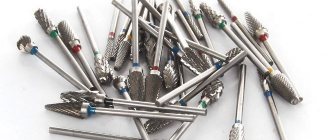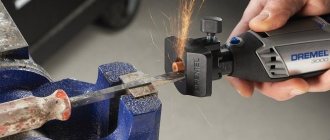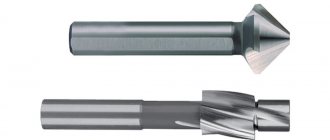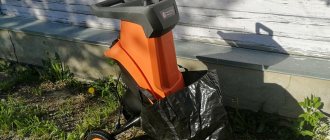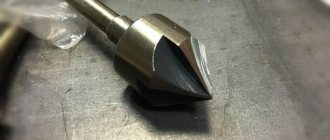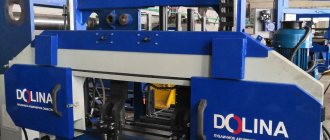Burrs, which can be used in conjunction with both a stationary machine and a conventional electric drill or screwdriver, are an almost indispensable tool in cases where it is necessary to process metal products. In addition, a burr, which is also called a roller cutter or a roller bit, is actively used to carry out such technological operations as cleaning a metal surface and grinding it, engraving, boring holes to the required size. In order for the processing performed using a metal burr to be effective, it is necessary not only to understand the design features of such a tool, but also to learn how to choose it correctly.
Burrs for metal processing
Carbide burrs
Carbide burrs are cutting tools used for removing welds, removing burrs, leveling surfaces, and finishing work on products made of plastic, wood and stone.
- Sort:
- Price
- Popularity
- View:
- Tabular
- Lowercase
Used on straight grinders with electric drive or pneumatic drive for processing the outer surfaces of profile parts (cutting edges, deburring and chamfering).
Used on straight grinders with electric drive or pneumatic drive for processing protruding parts of non-flat parts - grinding, processing joints, removing welded reinforcements.
Used on straight grinders with electric drive or pneumatic drive for processing surfaces inside complex profiles (processing radius grooves, forming internal radius mates).
Used on electric or pneumatic driven straight grinders to finish surfaces in narrow or hard to reach areas.
Used on straight grinders with an electric drive or a pneumatic drive for processing the internal surface of the “corner” type (cutting edges, removing burrs and chamfers, processing radius grooves, forming internal radius mates).
Used on straight grinders with electric drive or pneumatic drive for processing joints of cylindrical parts - grinding, processing joints, removing welded reinforcements.
Used on straight grinders with electric drive or pneumatic drive for processing the outer surfaces of profile parts (cutting edges, deburring and chamfering).
Used on straight grinders with electric drive or pneumatic drive for processing parabolic surfaces inside the profile - grinding, processing joints, removing welded reinforcements.
Used on straight grinders with an electric drive or a pneumatic drive for processing the internal surface of the “corner” type (cutting edges, removing burrs and chamfers, processing radius grooves, forming internal radius mates).
Used on straight grinders with electric drive or pneumatic drive for processing joints of cylindrical parts - grinding, processing joints, removing welded reinforcements.
Used on straight grinders with electric drive or pneumatic drive for processing remote (recessed) places in profile parts (cutting edges, deburring and chamfering, processing grooves).
Used on straight grinders with electric drive or pneumatic drive for countersinking and edge processing of cylindrical surfaces.
Burr manufacturing technology
The production of burrs is carried out in two stages.
- Making a shank for a burr.
The rod is cut.
- One end of it is threaded on a grinding and roughening machine.
- The rod is straightened on a straightening machine.
- The end is trimmed, centered and cut off.
- The second end is trimmed.
- The cone is machined and the chamfer is removed.
- A groove is milled on the cone.
- The workpiece is soldered to the shank.
Photo No. 3: making a burr
Metal burr: types and application features
Burrs, which can be used in conjunction with both a stationary machine and a conventional electric drill or screwdriver, are an almost indispensable tool in cases where it is necessary to process metal products. In addition, a burr, which is also called a roller cutter or a roller bit, is actively used to carry out such technological operations as cleaning a metal surface and grinding it, engraving, boring holes to the required size. In order for the processing performed using a metal burr to be effective, it is necessary not only to understand the design features of such a tool, but also to learn how to choose it correctly.
Burrs for metal processing
Purpose and features of the tool
The history of burrs goes back decades, during which this tool has been constantly improved. Meanwhile, in the time that has passed since the invention of the burr, its design has remained virtually unchanged. As before, any cutter consists of a shank, with which it is fixed in the chuck of the equipment used, and a working part, which performs the main cutting job.
Processing with burrs is carried out with a rotating tool, and its rotation speed can reach up to 60,000 rpm. In this regard, when using cutters, it should be taken into account that the equipment on which they will be installed must provide them with a high rotation speed.
The advantage of using burrs paired with hand tools is the ability to process hard-to-reach surfaces
When choosing metal burrs, you are guided by the following parameters:
- the type of processing to be performed;
- characteristics of the material from which the processed product is made;
- dimensions of processed elements.
It should be borne in mind that it is the correct choice of tool (along with its quality characteristics) that has the main influence on the results of the processing performed.
The cut of the burr must match the type of material being processed
Burrs designed for metal work, due to their characteristics and functionality, are widely used in many areas. This is, in particular, the mechanical and automotive industry, the electronics industry, jewelry, printing, etc.
Burrs, the working part of which can have very miniature dimensions and different configurations, are used to process the working surfaces of dies and casting molds, apply various patterns and inscriptions to the surface of metal products, bore and grind holes and grooves that even differ in significant depth and complex configuration.
Engraving burrs for miniature work
Metal burrs are also very popular among home craftsmen. Using such a universal and effective tool mounted on a regular electric drill or screwdriver, you can quickly and accurately clean a weld, bore a hole or groove, remove sharp edges from a part, grind small metal elements, and make the surface of a metal product perfectly flat and smooth.
Application of burrs
There are many areas of application for burrs. Among them:
- removing flash and specks from workpieces;
- grinding of surfaces, grooves and holes;
- processing of welds;
- performing various technological operations in hard-to-reach places;
- engraving;
- cutting complex shaped holes;
- etc.
Burrs are even used in the electronics industry, jewelry and printing.
Classification of burrs
Differences in the design of burrs of different categories make it possible to optimally select such a tool for solving certain technological problems. Burrs for metal are classified according to their design. So, depending on this parameter, they can be:
- single-cone;
- double-cone;
- three-cone.
Each of the types of burrs presented above is selected depending on the nature of the technological problems to be solved with their help.
Marking of carbide burrs
The shape of the working (cutting) head is another parameter according to which burrs are divided into different categories. Today, burrs are produced with working heads of the following shapes:
- cylindrical;
- conical;
- round;
- semi-oval;
- oval.
Shapes of the cutting part of burrs for metal
The choice of a tool with a working head of a certain shape is also influenced by the nature of the upcoming technological tasks. For example, for engraving on metal, a conical burr is used, for boring and grinding holes and grooves - a tool with a cylindrical working head, for cleaning welds and processing flat surfaces - rollers, the cutting part of which has a round shape.
The shape of the burr is selected depending on the configuration of the surface being processed
If we talk about the material used to make metal burrs, then depending on this parameter they are divided into the following categories:
- made of carbon steel;
- abrasive (burrs in this category are divided into two types: with a metal working head, the surface of which is coated with abrasive material, and with a cutting part made entirely of abrasive - electrocorundum);
- coated with diamond chips (diamond burrs);
- carbide (a hard alloy working head is attached to their carbon steel shank by soldering).
Metal burrs made of carbon steel are the most inexpensive of those presented, but their working life is minimal. You can purchase rollers of this type if they are not used too often and not intensively. Burrs made of carbon steels demonstrate their effectiveness when processing simple materials that are not too hard.
Plain Carbon Steel Burrs
Diamond burrs, which can be used to successfully process high-strength and brittle metals, are professional tools suitable for both home and industrial use. With the help of such cutters, the working heads of which can have any size and configuration, it is possible to bore and finely grind holes, and the surface formed after such processing is perfectly flat and smooth. It is diamond burrs that are most often equipped with engraving machines.
Carbide burrs, characterized by the highest working life among tools of this type, are used primarily in production conditions. Using carbide burrs, which are equipped with powerful and high-speed equipment, it is possible to process metals of the highest hardness (cast iron, stainless and heat-resistant steel, titanium, etc.).
Carbide burrs are suitable for shaping and finishing a variety of metal surfaces
Burrs used to perform metal work also differ in the type of sharpening of the cutting part. So, depending on this parameter, burrs can be:
- with fine cutting of the cutting part;
- with universal cutting;
- with ultra-thin slicing;
- designed for work on aluminum.
Classification of burrs by type of cutting head
Burrs vary in design. Depending on the technological tasks at hand, the shape of the cutting part of the tool is also selected. The correctly selected type of burr greatly facilitates the work, makes the geometry accurate, and the result close to ideal.
Type A – cylindrical burrs. Universal. Ideal for flats, burrs and holes.
Type B – cylindrical burrs with an end. Unlike type A burrs, they also have an end with a section. Versatile, excellent for surface treatment and sampling.
Type C – spherical cylindrical burrs. For surfaces and radii. The rounded end is a rational solution for smooth curves.
Type D – spherical burrs. Excellent processing of internal holes, bearing seats and contours.
Type E – oval burrs. They are ideal for rounded corners and smooth paths.
Type F – hyperbolic burrs with a spherical end. Proven solution for molded parts with soft contours.
Type G – hyperbolic burrs with a point end. For chamfering, forming precise angles, engraving.
Type H – flame-shaped burrs. Ideal for processing molded curved parts.
Type J – 60% conical burrs. The best option for countersinking at a given angle.
Type K – 90% conical burrs. For edges, chamfers, countersinking.
Type L – spherical conical burrs. For difficult places.
Type M – conical burrs. For hard-to-reach places, delicate tasks and spot drilling.
Type N – with reverse cone. This carbide burr is reliable and convenient for corners and hidden recesses.
Recommendations for correct use
To extend the service life of metal burrs, and also to avoid causing damage to the equipment, you should follow a number of simple recommendations.
- The working part of the cutter must be maintained in full contact with the metal being processed: this will increase the efficiency of its use.
- It is necessary to ensure that the shank does not come into contact with the workpiece, which can lead to breakage of the burr.
- During processing, strong mechanical pressure should not be applied to the tool: this will not only reduce its efficiency, but also increase the load on the equipment used, which can cause it to overheat and quickly fail.
- To avoid problems such as the formation of irregularities and burrs on the workpiece, as well as jamming of the cutter in the metal, it is necessary to set a high rotation speed of the tool. Working with a burr rotating at high speed also allows for more thorough processing of grooves and corners.
- To prevent intense wear of the tool, it is necessary to periodically apply a special lubricant to its working head during processing, which will reduce the load on the cutter and improve its sliding along the surface being processed. A suspension consisting of wax or synthetic machine oil, into which the burr is periodically dipped during processing, can also slow down the wear of the cutting part.
- Do not process with a heavily worn burr. The use of such a tool requires significant physical effort, and can also cause failure of the equipment used and the final breakdown of the tool itself.
Recommended operating speeds
When processing metal with a burr, safety precautions should be observed, since this process is associated with the formation of a large amount of small chips and metal dust. In addition, if you use a substandard tool, you must be aware of the risk of it breaking and the work head being thrown out of the processing area, which can cause serious injury. Thus, when preparing to work with a metal burr, it is necessary to reliably protect your hands, eyes and breathing organs.
Control and test methods
Burrs, despite their apparent simplicity of design, are very precise, durable tools that experience enormous loads. Its quality should be at its best.
Since the burr market is overflowing with offers from a variety of manufacturers, often seeking to increase production volumes at the expense of quality, control over compliance with GOST is necessary.
Large enterprises that regularly use burrs usually purchase them from several trusted suppliers. And they are periodically compared with compliance samples.
The quality of the material, the strength of the soldering of the leg and the working head, precise alignment, ideal geometry, the ratio of the bakelite base and high-quality abrasive - all this matters for the operation of the burr.
There are several control methods:
- Visually, with a magnifying glass and caliper, check the appearance and roughness;
- Using a microscope and using laser centerers, it is checked whether the burr has any deviations in alignment;
- Durability is tested using electrical or pneumatic equipment. The total length of the test milling is 3000 mm if d burrs < 10 mm, and 10000 mm if d > 10 mm.
After the test work, there should be no chips or chips left on the burr and it should remain suitable for work.
A simple quality check of a carbide burr can be carried out at home.
Review abrasive uniformity and grit calibration using a magnifying glass. Is the connecting seam between the working part and the pin strong enough or is the soldering done poorly, with large gaps.
You can, by holding the burr in the drill chuck, turn on the tool at high speeds - the asymmetrical shape of the rotating cutter, noticeable even to the eye, will indicate incorrect alignment.
Do not work with low-quality or worn burrs! This may cause damage and injury.
How to choose a burr for metal?
When processing metal workpieces in workshops, garages and car repair shops, an electric drill with equipment is often used. If you need to remove a layer of metal, process irregularities or enlarge a hole, use a metal burr. It is considered indispensable when working with metal products. Before purchasing cutters, it is important to understand what they can be made of and how to use them.
Metal burr
Material and design
A burr (also called a cutter) is one of the types of equipment for power tools, industrial equipment, and machine tools. Before the invention of these devices, a person scraped off a layer of metal with a file. This took a lot of time and effort.
The advent of milling cutters increased labor productivity. They can be used to process various metal workpieces. The cutter consists of two parts:
- End cap - fixed in the chuck of a screwdriver, drill, hammer drill, or drill.
- The cutting part is the working head of the cutter, with the help of which metal is processed. Burrs, which can be found in hardware stores, comply with the parameters specified in GOST.
Ball joints are divided according to the type of material from which the working head is made, the design, and the visual shape of the cutting part. Materials used in the manufacture of burrs:
- carbon steel;
- abrasive;
- diamond sputtering;
- hard metal alloys.
By design, burrs can be single-cone or double-cone. The cutters have different shapes:
- round;
- oval;
- conical;
- cylindrical;
- semi-oval.
Varieties
Metal burrs are used in metal processing. If everything is clear about the shape of the equipment, then choosing the material from which it is made is more difficult. To avoid mistakes, you need to study general information about what burrs can be made of.
Types of burrs for metal
Carbon steel
The most common type of attachments for electric drills used in processing metal surfaces. In their production, cheap, accessible material is used, which determines the low price for the finished equipment. Advantages:
- low price;
- wide selection of shapes.
- the quality is significantly worse than other materials;
- fragility;
- low quality.
The working part, made of carbon steel, is quickly ground down during active work.
Diamond coated
Diamond-coated metal burrs are used for many jobs. Advantages:
- Used for processing metal surfaces, glass, ceramics.
- Diamond coating is applied to equipment for drills and engravers. They are used to carry out jewelry work.
- High precision of work performed.
The disadvantages of diamond-coated cutters include their high cost. After working with this type of equipment, the results of rotating the burr are invisible on the surface being processed.
Abrasive tool
It is an abrasive material that is fixed to the working part of the cutter. It can be of any shape, size. The best abrasive material for the manufacture of this type of equipment is electrocorundum. Burrs with abrasive are used for processing wood, metal, glass, and ceramics.
Electrocorundum
With carbide head
The purpose of this type of equipment is the processing of cast iron, alloy steel, and titanium-based alloys. Advantages:
- the ability to process any type of metal;
- durability, wear resistance.
The disadvantages of these metal burrs include their high price. They are installed on high-power equipment to achieve maximum performance and accuracy.
Areas of use
Roller cutters made from hard alloys are used in various industries:
- manufacturing of ships, cars, airplanes;
- printing;
- processing of high-strength alloys;
- jewelry making;
- electronics.
Using burrs, you can bore holes, create inscriptions on metal surfaces, make grooves, and grind parts where it is impossible to reach with a grinder or grinder. Metal drill accessories are used to repair various metal structures.
Tool selection
When choosing accessories for hand or power tools, you need to consider a number of features:
- Type of operations performed: grinding, milling, boring, grooving.
- Type of material being processed. When working with ceramics or glass, it is better to use diamond-coated cutters.
- Dimensions and shape of the workpiece being processed.
When choosing a cutter for a drill, many beginners do not take into account the operating speed and power of the tool. The shape and size of the burr depend on these indicators.
Materials for the production of burrs
The material for the production of burr shanks is medium-carbon alloy steel. The main brand is 30HGSA. But burr heads are made from various materials. Let's list them.
- Tool carbon steel (U10A, U12A). Tools made from these materials have a short service life and are inexpensive. Used for processing soft metal products. Installed on drills and engravers.
- High-speed steel R6M5. Tools made from this material can be used to process almost all grades of carbon and medium-alloy steels. Such burrs are used most often.
- Hard alloys. The working parts are usually made of metal ceramics (VK25 and VK30). There are also products with heads made of mineral ceramics and tungsten-free hard alloys. These burrs are used to process workpieces made of heat-resistant and stainless steels, as well as cast iron.
- Hard alloys with diamond coating. This is the most expensive professional tool.
How to use it correctly?
After purchasing a metal cutter, you should not mindlessly get to work. It is necessary to take into account a number of rules that will help extend the durability of the equipment and maintain the integrity of the workpiece:
- Before starting the drill or the engine of the equipment, you need to secure the workpiece, think over a work plan so as not to stop during processing.
- Choose a power tool with a large power reserve.
- When the engine is running, do not touch the working surface with the shank. This may cause equipment failure.
- It is strictly forbidden to put pressure on the tool from above. The burr will break due to increased load.
- To increase the durability of the cutter, you need to use special lubricants. They improve gliding and cool the work area.
- Before starting work, it is necessary to check the integrity of the shank and working head. If there are chips, cracks, or unevenness on the cutting part, it must be replaced.
Car mechanics, blacksmiths, and tinsmiths recommend working at maximum drill speeds. This allows you to improve your workflow parameters and achieve better results. High speeds reduce the risk of the cutter jamming in the workpiece.
Choosing burrs for metal: expert recommendations
When working with metal workpieces in auto repair shops and various industries, craftsmen often use an electric drill with equipment. One of the most commonly used elements is metal burrs, also known as cutters.
The design of the cutter is quite simple. The burr consists of an end piece that is mounted in a tool chuck (drill, drill, or grinding device), and a cutting part, which is responsible for processing the metal.
The list of tasks that can be performed using carbide burrs is quite large. With these elements you can:
- Clean and process seams after welding;
- Grind surfaces and hard-to-reach places;
- Remove burrs;
- Process molds and dies;
- Remove specks and flash from the surface of the workpiece;
- Expand holes in metal;
- Handle uneven surfaces.
Depending on the type of tasks for which you need a burr, your financial capabilities and requests for the tool, the choice is determined.
Types of burrs for metal
In the manufacture of cutters, hard metal alloys, carbon steel, diamond coating, and abrasive are used.
As for the distinctive features, the most important are the shape and cut of the burr. Burrs of different shapes are presented on the modern market - a cylindrical shape without a cutting end and with end teeth, spherocylindrical and spheroconic, oval and spherical, a hyperbola shape and a hyperbola with a pointed end, a cone and an inverted cone, a flame-shaped shape and a conical shape with an angle of 60°.
There are combined cutters for solving certain problems. For example, to process the ends of products, you can use a Karnasch concave burr with a cylinder shape.
If you have no time or no need to understand the nuances of using different shapes of cutters, you can give preference to the most universal option - this is a flame-shaped burr, which has an oval-shaped working surface and a rounded head. This shape allows you to perform various operations, including working with the material at an angle.
Another important criterion that you should focus on when choosing a burr is the notches:
- Double cutter cutters are used for high material removal. Among the advantages are the impeccable quality of the work result, excellent controllability;
- Single fine cut. It is considered universal, suitable for solving various problems;
- Notches in the form of large grooves provide efficient and aggressive cutting and high material removal. Such attachments are used for working with non-ferrous metals;
- The cutter with a chip breaker provides high material removal and is characterized by improved controllability;
- Diamond cut. Allows you to ensure impeccable quality of the processed surface. Traditionally used for finishing materials and products.
It’s not enough to just decide on the type of burr. Rollers of the same type can have different parameters: length and diameter of the cutting part, length and diameter of the shank, small, medium or large type of tooth.
Working section profiles
Standard sharpening. Has one long notch. Suitable for cast parts, welds, alloys, brass, steel, including resistant heat-treated steel. Allows you to make large allowances. The shavings are long. Efficiency is optimal.
Double sharpening. It has cross-shaped notches on the working surface, resulting in the formation of teeth. Universal type. Suitable for working with any materials. Reduces burr vibration, allowing for better control of the process. Provides high cutting speed. Leaves a clean, smooth surface. The teeth formed as a result of notching are straight and multi-directional. A burr with this sharpening produces small chips.
Large sharpening. It has one wide notch (width and angle may vary). Great for soft materials such as aluminum and where large volumes need to be removed. Fast work with large chips.
What to look for when choosing a cutter for metal
The best option (if finances allow) is to choose and buy a whole set of metal burrs. But in some cases, even this approach cannot be called effective: there are quite a lot of diameters and shapes of cutters, so it is better to immediately decide which cutters you might need.
What to consider?
- Technological tasks. Different shapes of cutters are used for different technological operations, so the importance of this parameter is almost impossible to overestimate.
- Geometric parameters of processed products and their condition.
- Material of products that are processed. We can talk about different materials - it could be titanium, cast iron, aluminum, alloys, and so on.
- Diameter of the hole to be machined.
- Type of material processing. Different types of burrs are used for roughing, finishing and finishing of products.
It is worth including information about the quality of the burr and its manufacturer in a separate paragraph. You shouldn't skimp on this option. For example, if you decide to buy a Karnasch cylindrical cutter with a smooth end, you can be sure that the attachment will successfully cope with a variety of tasks, delighting you with flawless work for a long time. In the long term, such investments turn out to be justified.
However, it is not enough just to choose a good burr; it is also important to use it correctly.
Three tooth size options
- F - fine tooth
- M – middle tooth
- C – large tooth
Taking into account the surface profile, the tooth size designations look like this:
Now, knowing the characteristics of burrs based on materials of manufacture, profile types and types of notches, we can choose the right tool for the job, as well as “read” the markings of any burr.
The State Standard of the Russian Federation establishes the technical uniformity of units of measurement, standards of sizes, types, designations, steels, alloys, roughnesses and their permissible errors. So, according to GOST R 52780-2007, we will understand the marking of Borfrez S 10 20 M 06 40 GOST R 52780 - 2007 as follows:
- Spherocylindrical burr (type C),
- diameter of the cutting part - 10 mm,
- length of the cutting part - 20 mm,
- medium tooth, shank length - 6 mm,
- shank diameter - 40 mm.
The figure shows a spherical burr with standard sharpening.
When purchasing a burr in a store, you should definitely check for markings on the tool leg and on the packaging. Responsible manufacturers who produce quality products must label the product. The absence of such indicates, most likely, the low quality of the product.
How to use burrs correctly to make them last longer
There are not many rules for proper operation of cutters; they are quite simple, but at the same time they will help to significantly increase the life of cutters.
- When working with burrs, you need to take into account the working speed and the capabilities of the tool. Home drills cannot always produce good power, so high-quality finishing at home is almost impossible.
- To ensure a good result, make sure that the working head of the tool is pressed as close to the workpiece as possible. But the shank, on the contrary, must be distant from the product, otherwise there is a risk of breaking the tool head.
- Experimentally determine the optimal number of revolutions and speed of the machine - your correct actions in this direction will not only help save energy, but will also extend the life of the tool. You should not work at low speeds - this has a negative impact on the quality of the result: unevenness, burrs, and so on may appear. When working on grooves and corners, use a higher tool speed.
And lastly, don’t forget about safety measures. When working with burrs, protect your breathing organs, head, and hands from metal dust and chips. Sometimes the instrument may also fall off.
_ _ _ _ _ _ _ _ _ _ _ _ _ _ _ _ _ _ _ _ _ _ _ _ _ _ _ _ _ _ _ _ _ _ _ _ _ _ _ _ _ _ _ _ _ _ _ _ _ _ _ _ _ _ _ _ _ _ _ _ _ _ _ _ _ _ _ _ _ _ _ _ _ _ _ _ _ _ _ _ _ _ _ _ _ _ _ _ _ _ _ _ _ _ _ _ _ _ _ _ _ _ _ _ _ _ _ _ _ _ _ _ _ _ _ _ _ _ _ _ _ _ _ _ _ _ _ _ _ _ _ _ _ _ _ _ _ _ _ _ _ _ _ _ _ _ _ _ _ _ _ _ _ _ _ _ _ _ _ _ _ _ _ _ _ _ _ _ _ _ _ _ _ _ _ _ _ _ _ _ _ _ _ _ _ _ _ _ _ _ _ _ _ _ _ _ _ _ _ _ _ _ _ _ _ _ _ _ _ _ _ _ _ _ _ _ _ _ _ _ _ _ _ _ _ _ _ _ _ _ _ _ _ _ _ _ _ _ _ _ _ _ _ _ _ _ _ _ _ _ _ _ _ _ _ _ _ _ _ _ _ _ _ _ _ _ _ _ _ _ _ _ _ _ _ _ _ _ _
Exploitation
So, when starting work, it is important to remember the correct choice of standard size for the type of processing that is to be done - roughing, finishing, sphere, plane, etc.
For example, you should not use a spherical burr with a coarse cut to grind an internal sharp groove. To do this, it would be better to take a conical one with a double notch.
A carbide cylindrical burr with a double fine cut will make the plane ideal, while a spherical burr in this case can only ruin the workpiece. The harder the metal being processed, the smaller the cross-section of the burr should be - this is one of the basic principles of operation.
Failure to comply with this rule will lead to clogging of the grooves between the burr teeth, overheating of the tool, its rapid wear and poor quality work results.
The smaller the diameter of the burr, the higher the rotation speed should be. As the diameter of the tool increases, the number of revolutions per minute of the engine should decrease.
Use the maximum permissible speeds of the required modes. Otherwise, beating, chipping, and premature wear of the teeth are guaranteed.
When clamping the shank in a chuck or collet, a minimum area must be left free. This reduces vibration and minimizes the risk of shank breakage.
The force of pressure on the burr does not increase its efficiency, but increases the load on the tool and equipment. This may cause them to fail. Don't push!
It is necessary to remember the safety rules, protection of the organs of vision, hearing, and hands from possible damage. The eyes are the most vulnerable organ and to protect them you need to choose safety glasses wisely.
Special impact resistance markings on glasses will help you choose them correctly.
Existing designations for mechanical strength:
- S - high strength;
- F - for spent particles with a speed of 45 m/s;
- B - for spent particles with a speed of 120 m/s;
- A - for spent particles with a speed of 190 m/s.
In our case, when working with burrs, the speed of flying particles is no higher than 45 m/s, which means glasses with the letter F will be enough.
